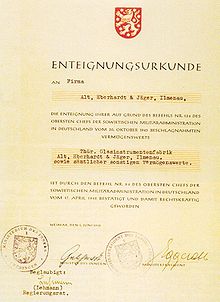Thuringian glass instrument factory Alt, Eberhardt & Jäger
The Thüringische Glasinstrumentenfabrik Alt, Eberhardt & Jäger was a German manufacturer of glass instruments based in Ilmenau ( Thuringia ), which existed from 1872 to 1976.
history
Before the First World War
The factory was founded on February 7, 1872 by August Eberhardt, Franz Jäger and Bernhard Fliedner in Ilmenau. At first she only owned a small factory in the old town (Burggasse). In 1874 the small company merged with Alt, Rieth and Krämer , another small company from Ilmenau (manufactory in Poststrasse). From then on the company operated under the name Thüringische Glasinstrumentenfabrik Alt, Eberhardt & Jäger . This company had three small production facilities (one in Burggasse and two in Poststrasse), but they were all in the old town and were unsuitable for large-scale production. In 1886 the company set up a branch in Geraberg , which later became the Geraberg thermometer factory with 2000 employees. Today this branch of the company has developed into an independent, listed company Geratherm .
In 1892 the first large factory was built in Ilmenau. She was logistically well situated on Station Ilmenau in the Bismarck street . After all parts of the company (with the exception of the Geraberg plant) were concentrated there, the company experienced a rapid upswing, which was mainly caused by the newly emerged chemical industry in Central Germany and on the Rhine. There was a great need there for glass apparatus and glass instruments that could be produced inexpensively and on a large scale by the Thuringian Glass Instrument Factory. In 1900 the factory's range comprised around 30,000 different glass instruments (mainly thermometers , pharmaceutical glass, chemical glass, and medical glass). At that time the company had around 400 employees.
The company founder August Eberhardt died in 1887, and August Alt took over the management of the company. When he retired in 1907, the company was converted into a stock corporation.
Between World War I and World War II
The good order situation required an expansion of production capacities before the First World War . That is why in 1912 another wing was added to the factory in Karl-Liebknecht-Straße. In 1917 only about 120 people were still working in the company, as many of the employees were drafted to the front, but the order books were still well filled so that the factory did not suffer any major damage due to the lack of personnel.
One problem was the procurement of sufficient raw glass for further processing. This had to be bought from the glassworks in Ilmenau and Stützerbach , which, however, became too expensive for the company management, which is why it was decided to found their own glassworks, which was to deal solely with raw glass production for the glass instrument factory. This hut was inaugurated in 1923. It was located opposite the main factory on Karl-Liebknecht-Straße and employed around 150 people.
The global economic crisis of 1929 also brought the glass instrument factory into trouble. She had to lay off many employees, so that of the approximately 300 employees before 1929, only 170 were left in 1932. The factory's economic situation only slowly improved again around 1935, so that the workforce grew again to 250 by 1936. In the Second World War, many employees were drafted into the Wehrmacht again , so that large gaps in personnel emerged, which the company tried to close by employing around 80 Eastern European forced laborers . After the end of the war, production was suspended between April and September 1945.
After the Second World War
When production was resumed in September 1945, it was initially geared towards the manufacture of urgently needed utility glass (including window panes , light sources (e.g. light bulbs ) and feeding bottles ). In the first time after the war there were repeated problems with the supply of raw materials, especially the energy supply with electricity, gas and coal was unstable.
On June 1, 1948, the company was nationalized and converted into a VEB . From then on, the factory was called VEB Glaswerke Ilmenau . In 1951 it had about 575 employees. This number rose to over 1,000 by 1961, as many small businesses were attached to the plant.
In 1976 the new large-scale combine VEB Werk für Technisches Glas Ilmenau am Vogelherd in Ilmenau was inaugurated in which VEB Glaswerke Ilmenau was also incorporated as its main component. That is why the old, now ailing, glassworks opposite the factory was closed in 1976. It was completely demolished in 1989. In the main plant on the other side of Karl-Liebknecht-Straße, however, production continued until 1991, before this plant was also shut down. On January 1, 1997, the site with the vacant factory was sold to a group of investors who wanted to build a shopping center there, although the complex was a listed building . It was then agreed to keep the facade of the factory and integrate it into the new shopping center, but to tear down the rest. This was realized at the end of the 1990s and the new “Mühltor Center” opened.
literature
- Horst Schön: Thüringische Glasinstrumentenfabrik Alt, Eberhardt & Jäger (1872 to 1976). In: Support and Friends of the Ilmenau Glass Museum eV (ed.): Glass in Ilmenau. Ilmenau 1998.
Web links
Coordinates: 50 ° 41 ′ 0 ″ N , 10 ° 55 ′ 8 ″ E




